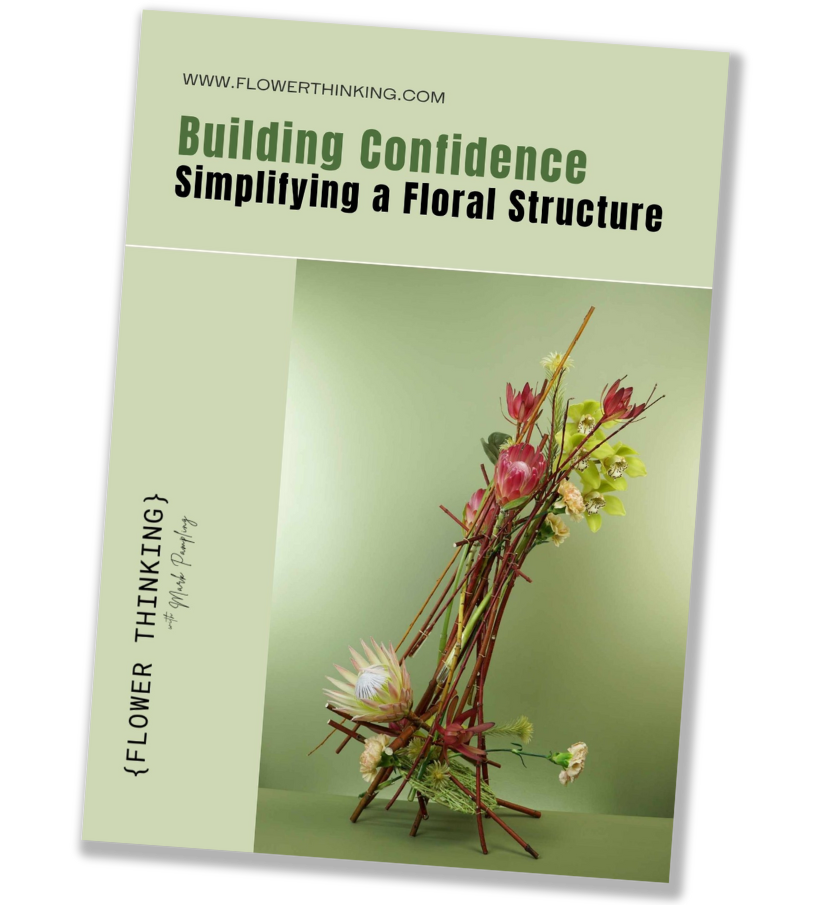
Design Directions
Exploring Principles through Proportion
Each different way in which proportion can be directed presents unique challenges in the application of Design Principles.
Design Directions seeks to explore design principles using as its viewpoint the different ways in which proportions are directed in the system of design classification in Gregor Lersch's Principles of Floral Design.
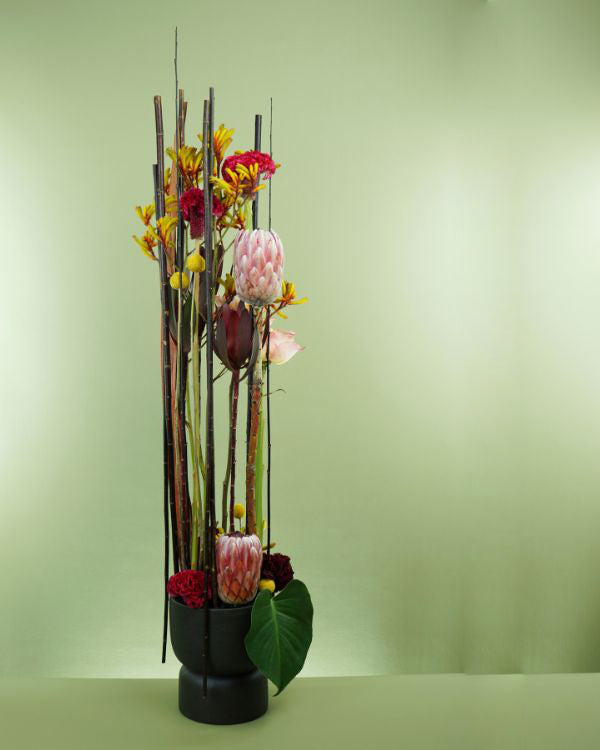
Working in a parallel system teaches you to pay particular attention to the linear characteristics of the material.
Protea, Celosia, Anigozanthos, Rosa, Salix, Craspedia, Leucadendron, Philodendron
Design – Mark Pampling
Photography – Mark Pampling
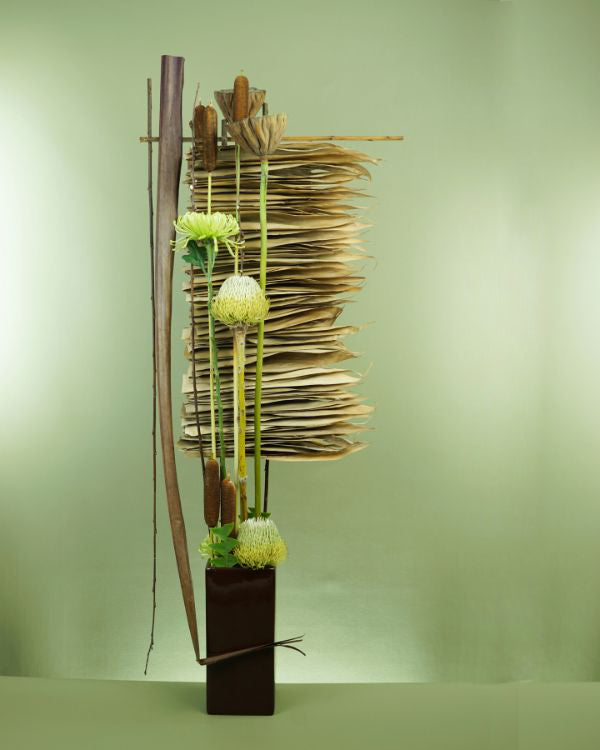
Two parallel systems, the vertical having the actual floral materials and a horizontal one with a decorative screen of bamboo leaves at the back.
They are joined together by two very long linear forms that create strong line direction starting in the upper left hand side and sweeping all the way down to near the base.
Banksia Baxteri, Chrysanthemum, Typha latifolia, Nelumbo nucifera, Corypha, Salix, Bambusa
Design – Mark Pampling
Photography – Mark Pampling
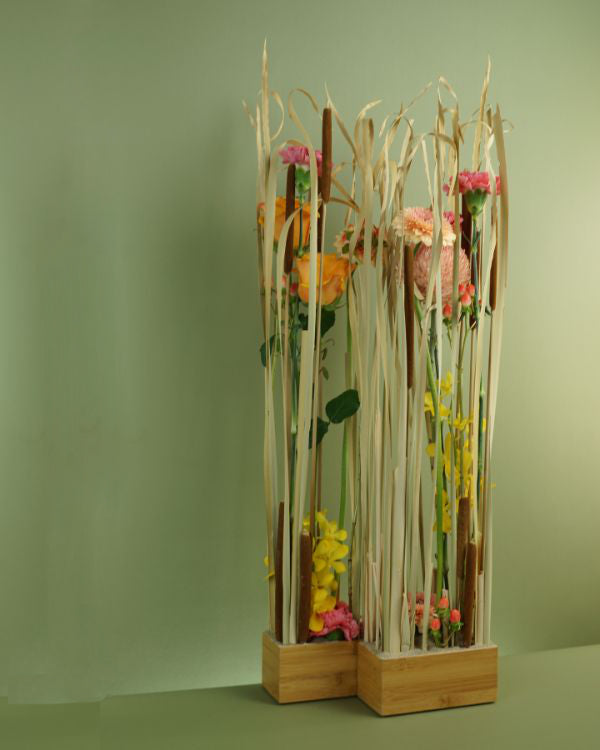
Parallel design using two offset rectangular containers to create a greater overall sense of depth.
Dianthus Caryophyllus, Typha latifolia, Rosa, Chrysanthemum, Gerbera, Hypericum, x-Mokara spp.
Design – Mark Pampling
Photography – Mark Pampling
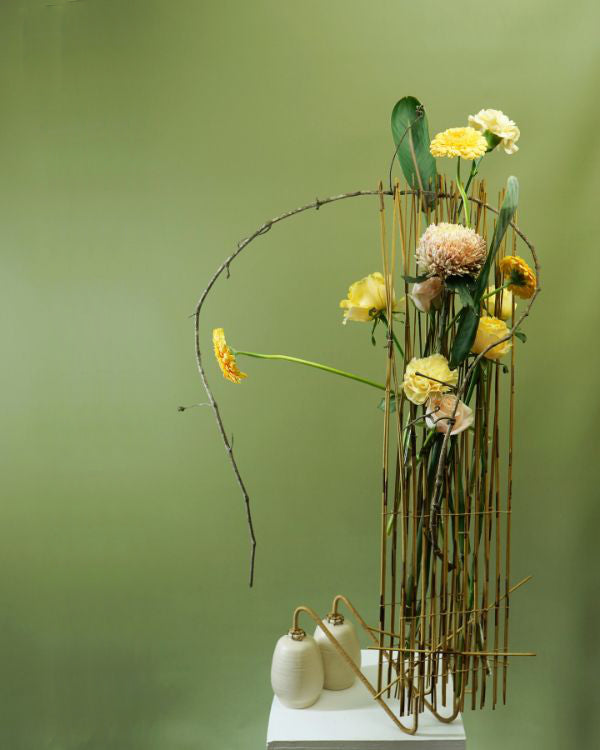
Comprised of two different systems, the underlying foundation of two bottles with tatami screens is parallel, but the actual flower placements are overlapping.
A dynamic line helps capture space and define the overall silhouette of the design.
Dianthus Caryophyllus, Typha latifolia, Vitis, Rosa, Chrysanthemum, Gerbera, Strelitzia
Design – Mark Pampling
Photography – Mark Pampling

Designing in a Formal-Linear way teaches you to be more aware of the individual characters of materials.
You become better at utilising the forms and lines of materials, a skill that benefits your work in all design styles.
Zingiber, Dracaena, Xylomelum, Strelitzia, Gerbera, Banksia, Rosa, Craspedia, Salix, Nelumbo nucifera, Philodendron monstera, Nephrolepis
Design – Mark Pampling
Photography – Mark Pampling
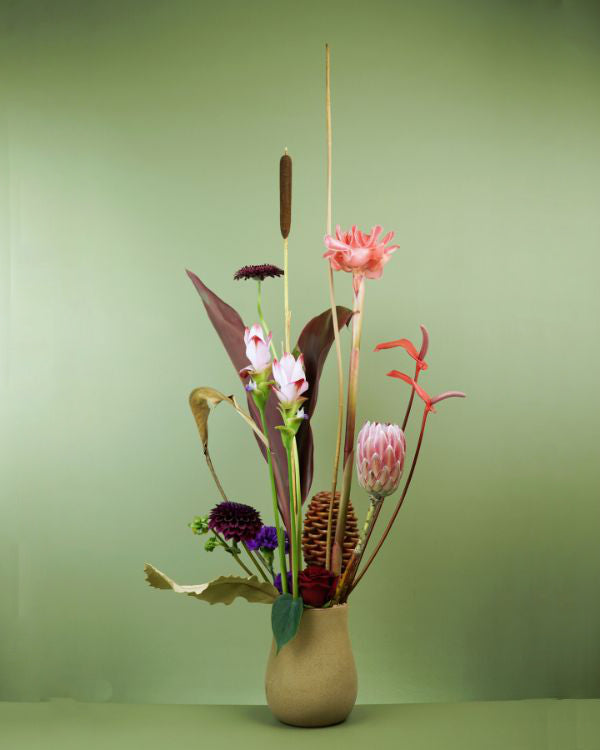
Radial Formal-Linear Design with Decorative Elements
The majority of materials are placed such that you can clearly see their forms and their lines.
Some materials have been used decoratively; they help to harmonize the overall design.
Anthurium, Zingiber, Curcuma, Cordyline, Protea, Strelitzia, Gerbera, Banksia, Rosa, Dianthus caryophyllus, Lepironia, Typha latifolia, Philodendron
Design – Mark Pampling
Photography – Mark Pampling

Radial Formal-Linear Design with Point of Emergence Below Container
This design appears almost to have some characteristics of a parallel arrangement. In fact, if you trace all the lines back down, they converge at a point well below the container.
Banksia baueri, Banksia, Dryandra, Dianthus caryophyllus, Zingiber, Sansevieria, Celosia, Typha latifolia, Pennisetum, Strelitzia, Erica, Leucadendron, Asparagus
Design – Mark Pampling
Photography – Mark Pampling
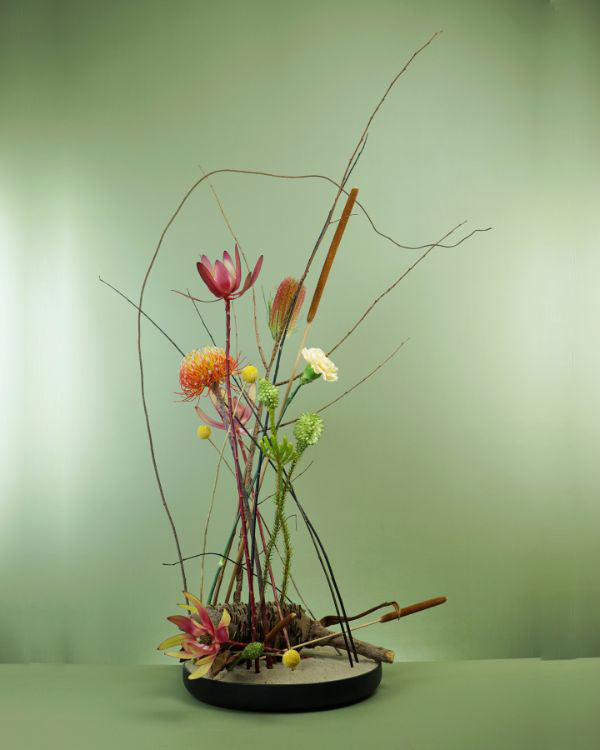
Overlapping Formal-Linear Design
Here, negative space is used on varying scales.
A length of Jasmine vine captures a large area of negative space around the left hand side and upper areas, helping to define the silhouette.
Leucospermum, Banksia, Leucadendron, Erica, Typha latifolia, Dianthus caryophyllus, Jasmine, Craspedia, Salix.
Design – Mark Pampling
Photography – Mark Pampling

Low Design with Parallel System on Diagonal
Minimal use of green and extensive use of sorghum, tingting sticks, bullrushes and lentils makes this design mostly about brown. Working on an angle like this forces you to pay more attention to the linear qualities of the material, to create a strong impression of parallelism.
Strelitzia reginae, Rosa, Celosia, Sorghum, Typha latifolia, Lens.
Design – Mark Pampling
Photography – Mark Pampling
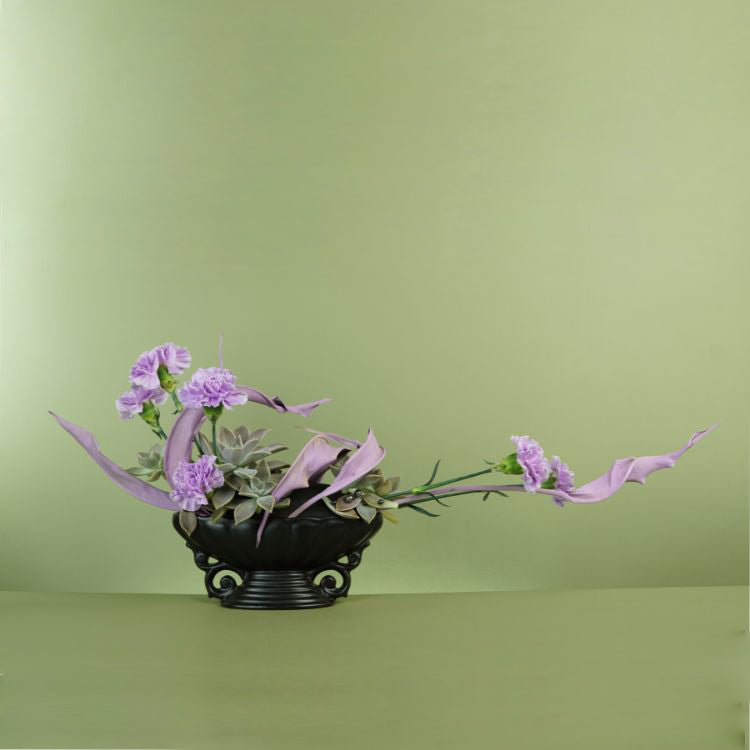
Radial Asymmetrical Design
Asymmetrical and uneven organisation of materials with a strongly contrasting colour scheme produce a contemporary feel in a classical urn.
Dianthus caryophyllus, Echeveria, Strelitzia
Design – Mark Pampling
Photography – Mark Pampling

Low Design with Two Parallel Systems
An eclectic collection of materials is unified in a strictly organised parallel system.
Dahlia, Sedum, Leucadendron, Hypericum, Rosa, Strelitzia, Celosia, Dianthus caryophyllus, Typha latifolia, Salix, Philodendron, Lens.
Design – Mark Pampling
Photography – Mark Pampling

Leaning Design with Two Line Systems
A panel of dried bamboo leaves in a parallel system provide a backdrop to botanical materials organised in an overlapping system.
Zingiber, Dianthus caryophyllus, Alocasia, Celosia, Helichrysum, Typha latifolia, Bambusa, Salix
Design – Mark Pampling
Photography – Mark Pampling
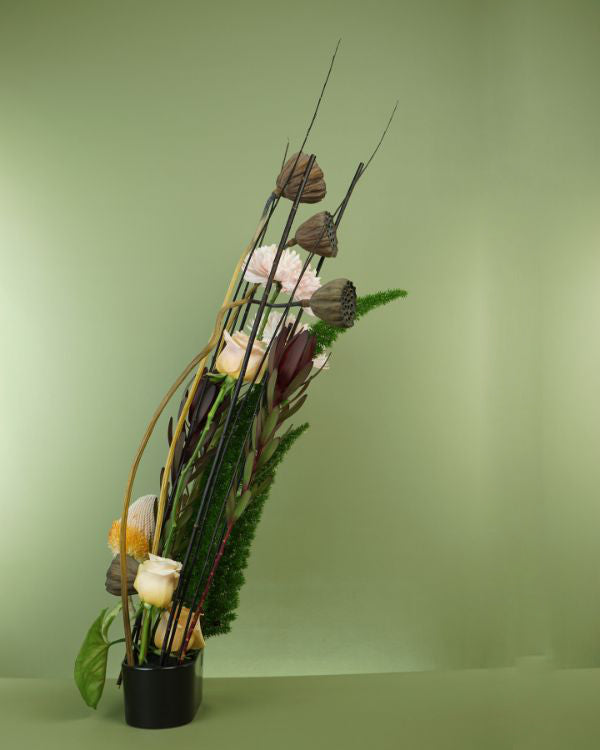
Leaning Design in Parallel System
One of the key things that this design shows us is the importance of negative space under the lean.
Nelumbo nucifera, Asparagus, Rosa, Banksia burdettii, Chrysanthemum, Leucadendron, Syngonium, Salix
Design – Mark Pampling
Photography – Mark Pampling

Asymmetrical distribution of the main areas of interest requires consideration to create feeling of visual balance. Use of negative space also helps.
Protea cynaroides, Protea hybrid, Cymbidium, Leucadendron, Phylica, Dianthus caryophyllus, Cornus, Salix
Design – Mark Pampling
Photography – Mark Pampling

A key feature of long designs is that the visual weight starts at the top, drawing the eye in from the top and then flowing down.
It's important to have enough visual interest at the top to lead the eye back up again.
I've done that here by clustering some really large forms at the top and also by repeating some of the materials in the top and bottom, like the Leucadendrons and the dried lotus pods.
Banksia baueri, Banksia, Dryandra, Strelitzia, Celosia, Nelumbo nucifera, Sechium, Melaleuca, Leucadendron
Design – Mark Pampling
Photography – Mark Pampling
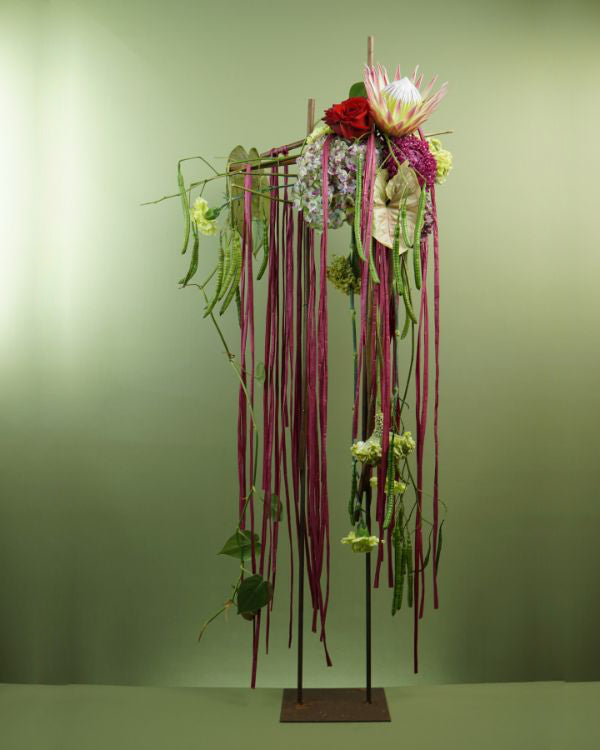
When working with strong downward directed energy, attention is required to ensure that the eye, once drawn down, has reason to return to the top of the design. In this case I used strong forms and areas of dense interest in the upper right area of the design.
The downward directed feeling here is created principally by the paper raffia hanging from the upper structure, along with botanical materials.
